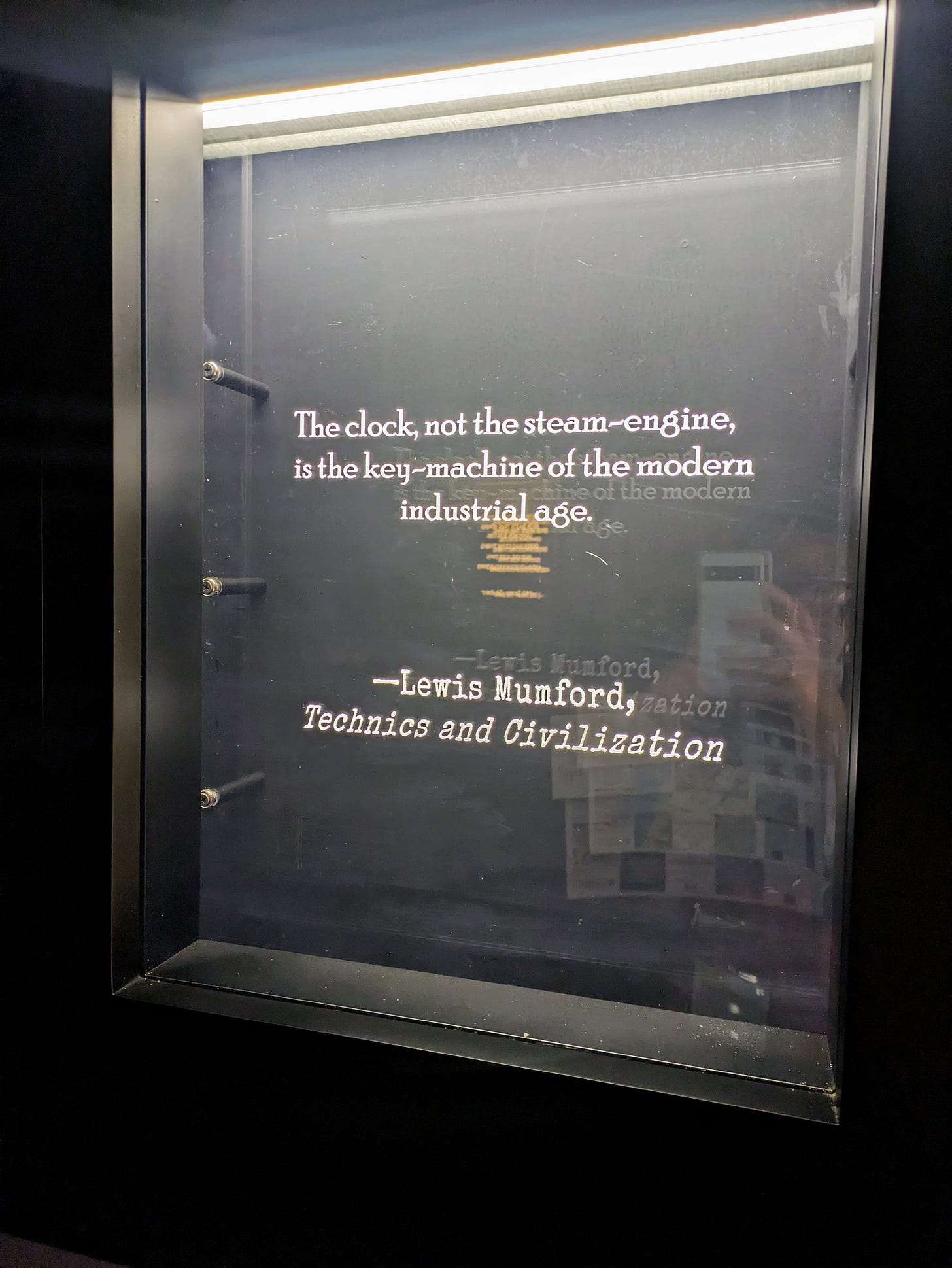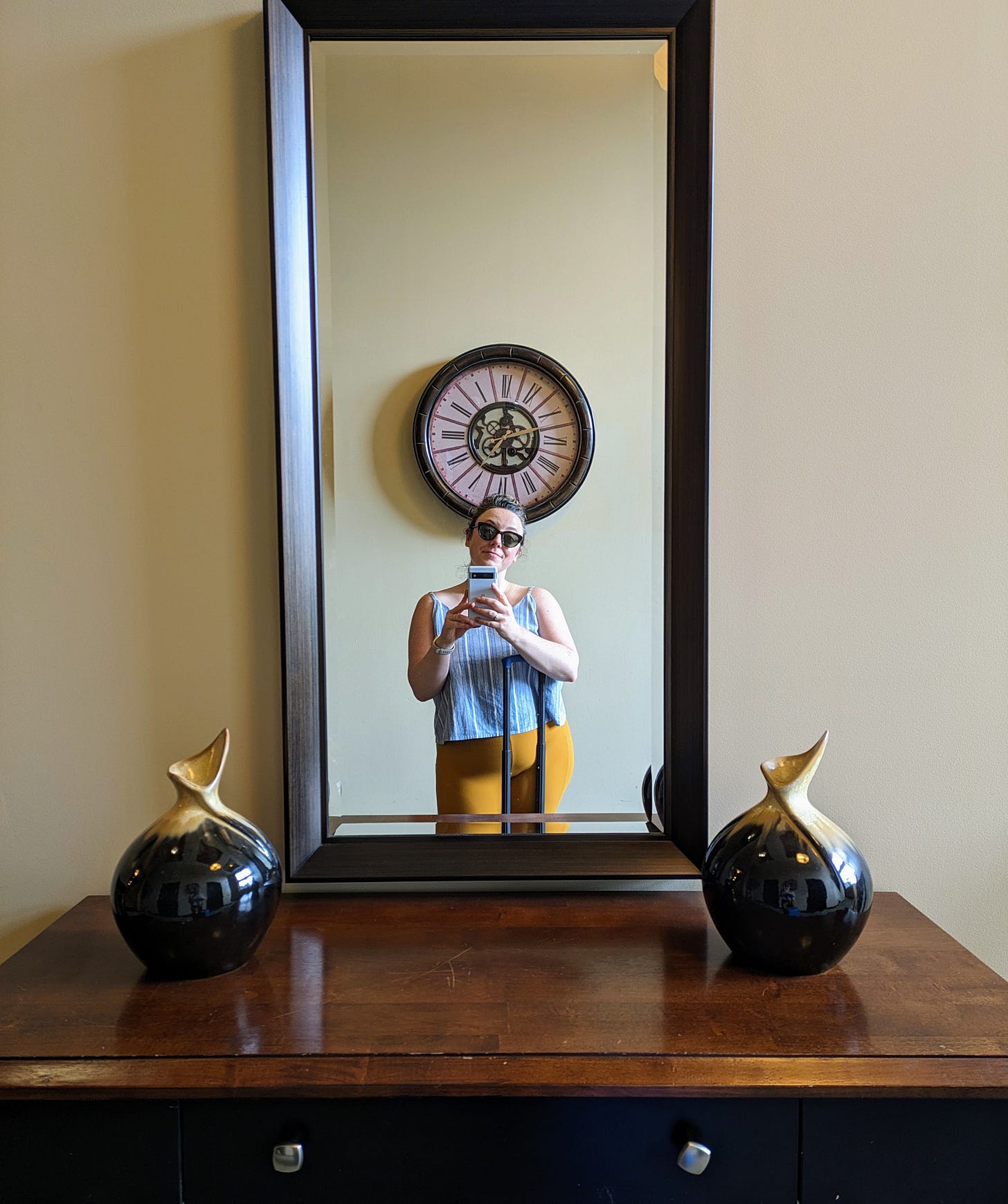Keeping Creative Time—writing from the other side of burnout.
Subscribe for the stories.
Stay for the tools.
Then share what works.
As primordial man evolved to higher and higher stages of cultural development, he became evermore acutely aware of the need to regulate everything he came in contact with, including himself. In fulfilling this need, he gradually established portions of day and night to accomplish certain tasks, i.e., hunt, eat, work and sleep. By observing the passage of the sun and stars through the heavens, a simple and easy method of telling time was developed.
Still this was not enough. Closer regulation of man and his activities was needed to cope with the monumental tasks that continued to escalate with the advancement of civilization.
—Horology Americana by Lester Dworetsky and Robert Dickstein
When I sit on the edge of the worn, three-legged wooden stool in my dad’s clock repair shop, I like to ask him questions about time itself; this mysterious thing he repairs is, to me, both fiction and reality. On this particular day, I probed him about how we got things done before the mass production of clocks and watches, way before GPS told us the time on our phones, back when we looked to the star that is the heart of our solar system for guidance: the sun.
“Go back to the mouse,” he sputters without even looking up from his workbench. “It knows what to do because of changes in its environment. Light or dark. Cold or warm. A mouse lives by feeling.”
“And how do we live?” I ask.
Dad looks up, the clock movement in his hands lays motionless. “Us? Why people are always doing things based on the time the clock tells them.”
This intrigued me.
“So humans have stopped feeling time?” I ask.
“Ever since the industrial revolution, we go by what the clock says. We wouldn’t be able to plan anything without clocks,” Dad continues. He’s wearing one of those funny eyepieces for magnification. Takes it off, leans back in his chair, resigning himself from the task at hand to give a mini horological lecture. “We’ve lost touch with how time feels because we believe there is not enough of it, no second to waste or be idle.”
I start to wonder, did we humans, with the creation of the clock, unknowingly divorce ourselves from the feeling of time?
In Keeping Watch: A History of American Time, Michael O’Malley writes about the major shift in American life during the nineteenth century that fueled the advancements we have today. “At the dawn of the industrial revolution, nature gave evidence of time’s passage. The sun’s transit, the moon’s phases, the passing seasons—all these indicated time and offered a model for using it wisely. In a very real sense, ‘nature’ and ‘time’ meant the same thing.”
As our society shifted from one of an agrarian lifestyle to an industrial one, knowing and keeping the correct time became more important. The more we needed to connect with one another over geographical distances, the more we needed a strict adherence to timekeeping. As O’Malley notes, clocks went from being a symbol of time, to time itself.

I haven’t been paying much attention to the timing in my own life. It feels some days, like an infinite scroll. Time happens, I do things, more time happens, I do more things; keep scrolling.
Dad keeps on going, “People are always doing things—doing time!”
He stands and holds out his hands as if to say, “ta-da!” then makes a beeline toward another clock movement; his patients are waiting.
“Humans are always looking to improve their life: striving. It’s because of our awareness of time. The clock is a measurement of time passing.”
Our time, I think. Our most precious resource.
“The measurement of time allows us to assemble, to know what time to travel and arrive, the planning of our routines, of our day. It’s this awareness of time—365 days in a year, twenty-four hours in a day, and our belief that there is never enough of it—that leads us to strive to do more and feel less.”
Do more. Feel less. An always growing to-do list. Anxious thoughts that keep me thinking about the things I have to do, I sometimes forget what it is I’m doing in the moment.
“We wouldn’t be able to plan anything without clocks.” Dad is now is full orator mode. The ever present ticking of the clocks in his shop, the ones that do work, begin to fade as his voice gets louder. “Everything would be chaotic. No organization would be able to accomplish goals, we wouldn’t be able to improve our lives and innovate. Human beings are driven by desires for accomplishment—money, things, growth, power. The clock is responsible for helping to structure and organize one’s life.”
With his words ringing in my ear, I think of the poet Mary Oliver’s essay “Of Power and Time” from the collection Upstream. I discovered it in that serendipitous way that the books meant for us find their way into our lives. During my last full summer living in New England, I thought it was time I visited Provincetown, Massachusetts, a sandy spot of land at the curved tip of Cape Cod National Seashore. My husband and I rode our bikes from one of the visitor parking lots to Race Point Beach. It was desolate for July compared to what I’m used to, being one of the sardines in a can on a beach in Narragansett, Rhode Island. When my hair was beach blown enough, and we’d fully digested our peanut butter and jelly sandwiches, we rode back, making a stop at the Province Lands Visitor Center. I knew Mary Oliver had lived and wrote here in this coastal landscape, and that nature was paramount to her work. I didn’t really know her beyond the poem “Wild Geese” (please read, it if you don’t know it!), and when I saw a selection of her books for sale on a bookshelf facing the water, there was a feeling, a knowing; I was in the right place at the right time. Her books were calling.
In that essay she writes about the types of work that “must travel beyond the realm of the hour and the restraint of habit.” This is spiritual work, of course, but artistic work always, she writes. “Neither is it possible to control, or regulate, the machinery of creativity. One must work with the creative powers—not to work against; in art as in spiritual life there is no neutral place.”
And this is why I struggle to keep time. In a world we’ve built for production without rest, a world we’ve built around machines designed to help us organize our lives more efficiently and connect with others, we’ve cut ourselves off from feeling our own time; our nature.
“There is a notion that creative people are absentminded, reckless, heedless of social customs and obligations. It is, hopefully, true.” — Mary Oliver, Upstream
I am a creative person who struggles to keep to a schedule, who struggles to be productive with my time. I get lost in time, immersed, swimming the black waters of deep fascination, wonder, big ideas, and enchantment. But other times I’m just stuck in the spinning vortex of my own mind. The black hole of anxiety and fear.
Is time really the enemy, or is it us?
As part of my burnout recovery, I’ve been exploring another way to keep time beyond the use of a clock—my body! I believe that keeping time in our own bodies is a radical act of resilience in a culture that has lost the value of presence within ourselves and with one another.
Keeping time asks us to step out of clock time and feel time in our own bodies, rather than getting stuck in the friction that is the stress of life. It asks us to experience the world through feeling, intuition, and awareness of our energetic bodies, our environments, and the living beings around us.

In gaining a more aware sense of our body clocks, regulating our own speed, finding our natural rhythms, expanding our circles of time rather than forcing straight lines to the future, might we find nestled in that space there is more time for empathy, kindness, and compassion? If so, I believe it could be an answer to the burnout culture we face, and a path toward creative awakening. We might become less machine-like and more human; less clock and more time.
In the context of the theme for my writing, keeping time is a promise to myself to learn how to mark and announce time in my own body. This is important to me, especially in the context of keeping creative time—the time to write, play, stare out the window, take a walk in the forest, enjoy the company of a friend, build connections in our world, just be more me. It means learning more about how I work as a system, why my mind does one thing and my body something else. How do I get the parts to function as a whole? How do I keep my energy levels regulated? Avoid the spikes of crash and burn that keep me off beat.
Sharing space with anyone else means sharing energy—literally. . . . We’re made of energy. The nature of energy is to be shared, to spread, to connect one thing to another. Sharing space with other people means that our energy influences theirs, and their energy influences ours. It’s physics. And psychology. And unavoidable. And amazing.
—Burnout: Unlocking the Stress Cycle by Emily and Amelia Nagoski
The authors of Burnout: Unlocking the Stress Cycle say that connection is a feeling. That life is complicated, expensive, and time-consuming. That we need help from one another to survive. I say yes to all of that! And I say that time is a feeling. It’s knowing when to do (or not do) things based off subtle changes in our environment, and our environment includes both our bodies and the larger energetic world we inhabit.
There’s something you should know about the mechanical timepieces my dad repairs, and what surprises they’ve shown me when I sit on that worn three-legged stool in his workshop. Each one keeps time a little different from the other. Each one has their own beat, the speed affected by their environment—dirt, dust, humidity, temperature—even some who’ve experienced man-made or natural disasters. At the top of the hour, you’ll notice each clock strikes or chimes at slightly differing times, the appointed hour stretching out for several minutes as every clock makes itself heard.
When I raised the observation to Dad that he seemed to be conducting a symphony rather than a tightly regulated time schedule, he got a little defensive, “It’s so I can enjoy the sound of each clock’s chime,” he hissed.
A clockmaker’s daughter knows one thing for sure—there is no “correct” time to keep, except when the rest of the world expects it to move or connect at a dizzying speed. It takes a radical act—like setting your clocks at different times, being forced to stay at home due to a global pandemic, or beginning to notice how your body feels in this moment, in this breath—to ask oneself who is keeping time for whom, and why?
This essay is dedicated to my creative husband and partner, Scott. We’ve been keeping time together since 2006, and somewhere in that time we got lost in the old stories inside our minds. Do the creative thing that makes you feel good. Resistance to your creative self is futile. Trust me, I know. <3 xoxo
Until Next Time
Take care y’all, and thanks for being here with me. Let’s cheer—to time!
And before you go, enjoy a song from the playlist I call . . . Odes to Time.
Greg Graffin —“Watchmaker’s Dial”—Cold as the Clay, 2006.




